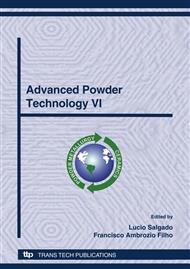p.329
p.335
p.341
p.347
p.352
p.358
p.362
p.368
p.374
Thermal Decomposition and Solid Characterization of Calcium Oxide in Limestone Calcination
Abstract:
This work is concerning to production of quicklime (CaO) from thermal decomposition of the calcite limestone (CaCO3) using analytical and instrumental techniques (TGA and MS) to evaluate kinetic and thermodynamic effects as well as heat/mass transfer associates with the process operation. On the other hand, experiments of morphologic, structural and textural characterization (XRD, SEM and BET surface area) were carried out in order to evaluate the quality of the quicklime produced. Under experimental studied conditions it was observed that carbon dioxide (CO2) inhibits the thermal decomposition reaction rate. In addition, it was observed that steam (H2O) can catalyze this reaction but it can also cause sintering of the oxide formed. It was also observed that the calcination reaction is greatly limited by mass transfer effects and that the controlled thermal decomposition generates an increase in the solid porosity. The formed CO2 have also increased the sintering phenomena in the oxide structure, resulting in less reactive quicklime.
Info:
Periodical:
Pages:
352-357
Citation:
Online since:
August 2008
Price:
Сopyright:
© 2008 Trans Tech Publications Ltd. All Rights Reserved
Share:
Citation:


